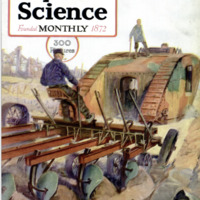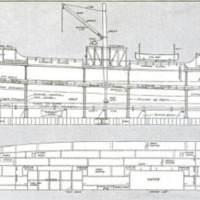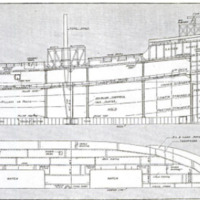The cargo ships used by the U. S. A. to carry troops, weapons and supplies to Europe
Item
-
Title (Dublin Core)
-
The cargo ships used by the U. S. A. to carry troops, weapons and supplies to Europe
-
Article Title and/or Image Caption (Dublin Core)
-
The Anatomy of a Modern Ocean Camel: Why Our Troops Reached France in Time
-
extracted text (Extract Text)
-
LAST winter was so cold that |
enough ice must have formed to
provide a generous supply for the
dog-days. But shortage of labor,
that old war-cry, applied itself
to ice-cutting as well as to other
industries.
Hereis an excellent scheme
to make up for the absence
of ice-cutters. It is worth
trying out if you haven -
automobile, a cuidng.
machine, some ice, a
place to keep it in when cut, and a
friend to help you do it. Simply at-
tach the cutting-machine to the auto-
mobile, and let the car pull the cutter
across the ice.
Lest the car skid on the slippery
ice, the two back tires should be
removed and iron rims with spikes
on them substituted. As an extra
precaution, put chains on your front
wheels.
One man runs the automobile
and the other guides the machine.
If your friend is good-natured, let
him trot behind with the cutter
handle in his hand. If he is not,
do it yourself and let him run the
car.
Provided one has the facilities,
it is quite possible for two men, one
automobile, and a cutting-machine
to do the work of many ice-cutters.
the keel and the hold the ballast-tanks
extend through the entire length and
width of the ship. The engine-room
occupies a comparatively large space
amidship, and has an air and light
shaft extending to the top of the
bridge-deck and covered with a sky-
light.
The boiler-room also has a shaft
to the bridge deck, and the furnace
flues go through the second, upper,
and bridge-decks to the smokestack
or funnel. From the engine-room the
propeller-shaft runs aft to the propeller,
which is placed between the rudder and
the stern plates of the vessel. In its
entire length it is enclosed in a tunnel,
and at intervals it rests upon supports,
called plummer-blocks, which hold the
heavy shaft in line. -
Above the hold of the vessel is the
second deck, which, like the hold, is
intended for the storage of cargo.
The lower coal-bunkers are in com-
partments above the engine-room and
the boiler-room, surrounding the air-
shafts.
In the bow section of the second
deck are the store-rooms and chain
lockers. The upper deck has the crews
quarters aft and cargo space at the
bow, surmounted by the platforms for
the forward and aft guns. Winch
platforms surround the fore-mast and
the main-mast, with their boom der-
“ricks for - hoisting or lowering cargo
through the big hatches.
The life-boats are placed aft of the
bridge-deck, which occupies the great-
er part of the space between the two
masts. Underneath the bridge-deck
are loading spaces and the upper coal
bunkers, and the bridge-deck contains
the living quarters of the officers, the
galley, directly aft of the boiler-hatch
and funnel, the captain's office, the
wireless-room, the chart-room, and the
‘wheel-house.
-
Language (Dublin Core)
-
eng
-
Date Issued (Dublin Core)
-
1919-02
-
pages (Bibliographic Ontology)
-
34-35
-
Rights (Dublin Core)
-
Public domain (Google digitized)
-
Archived by (Dublin Core)
-
Davide Donà
-
Marco Bortolami (editor)
 Popular Science Monthly, v. 94, n. 2, 1919
Popular Science Monthly, v. 94, n. 2, 1919




